MY WORK
Portfolio
Wireframe – wholesale management
 This is a low-fidelity wireframe for a sales reporting web portal. The web portal is hosted by a third party data supplier and supplies a number of wholesale clients with their sales data and inventory analysis. Clients use this information to allocate inventory according to need. In designing this wireframe, artifact location is more relative than absolute. Fillers are used to indicate where data would be displayed without confusing purveyors with ‘approximate exactitude’. The design included three main tabs as well as sidebar filters and bookmarks.
This is a low-fidelity wireframe for a sales reporting web portal. The web portal is hosted by a third party data supplier and supplies a number of wholesale clients with their sales data and inventory analysis. Clients use this information to allocate inventory according to need. In designing this wireframe, artifact location is more relative than absolute. Fillers are used to indicate where data would be displayed without confusing purveyors with ‘approximate exactitude’. The design included three main tabs as well as sidebar filters and bookmarks.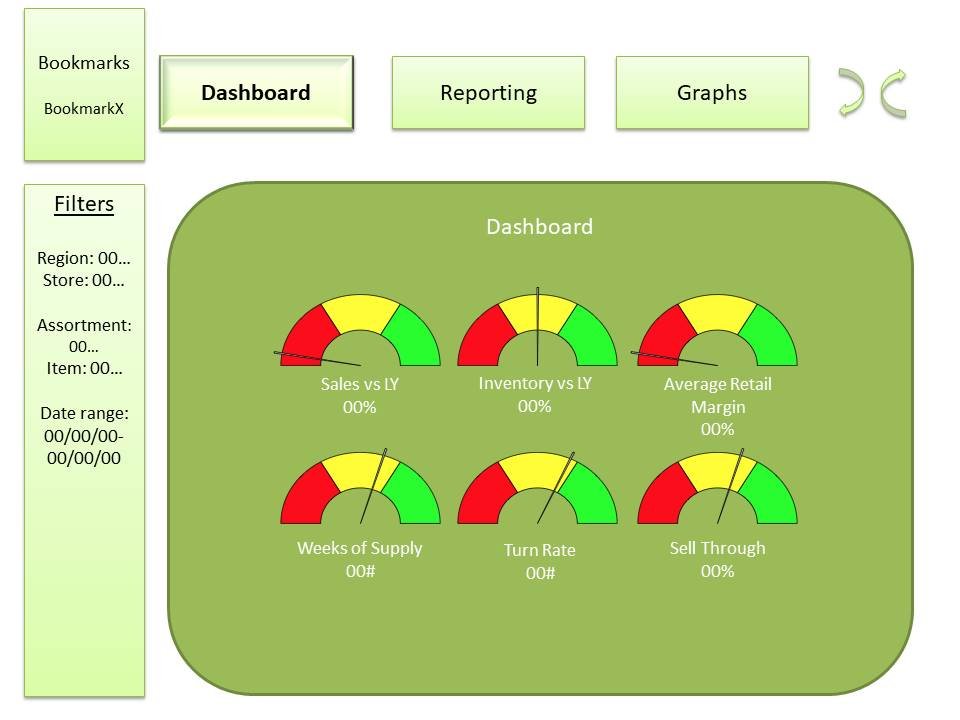 This slide shows the “dashboard” for a sales data web portal. This page would function as the home page and give the user an overview of sales trends. Dials are preferred over strictly numeric readouts for visual appeal and readability.
This slide shows the “dashboard” for a sales data web portal. This page would function as the home page and give the user an overview of sales trends. Dials are preferred over strictly numeric readouts for visual appeal and readability.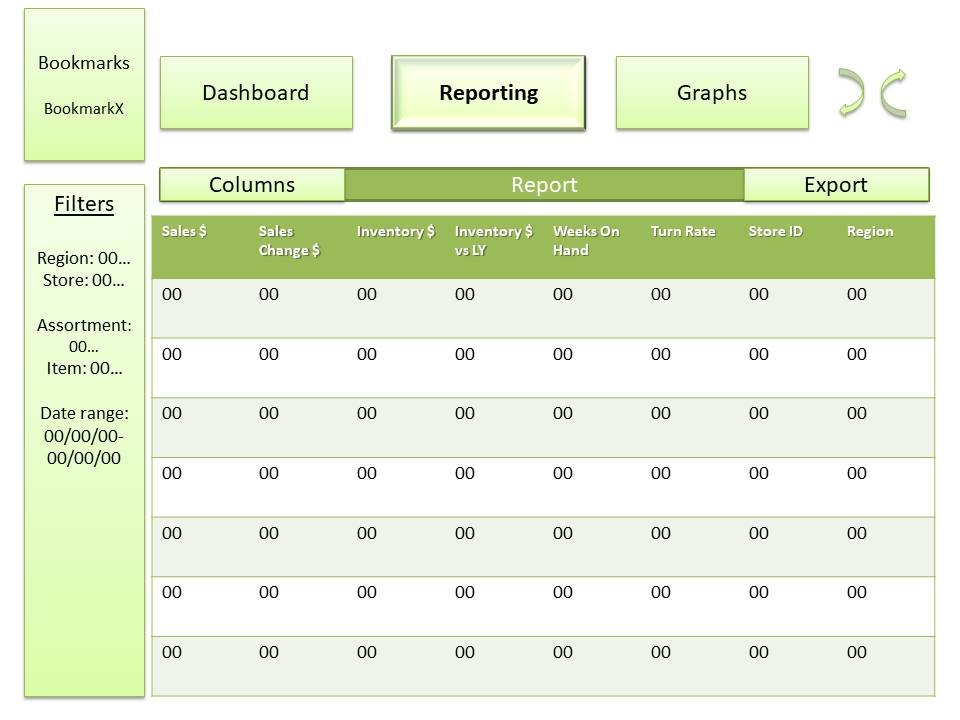 A simple readout that can be exported to Excel or other database software throughput is important in this case. Clients were taking data from this web portal and exporting to their own sales order writing templates, usually using Excel. Having a simple 1:1 transfer is important. Also included is the capability to filter and format similar to how a user would in a pivot table. Region, assortment, and date range filters carryover between pages.
A simple readout that can be exported to Excel or other database software throughput is important in this case. Clients were taking data from this web portal and exporting to their own sales order writing templates, usually using Excel. Having a simple 1:1 transfer is important. Also included is the capability to filter and format similar to how a user would in a pivot table. Region, assortment, and date range filters carryover between pages.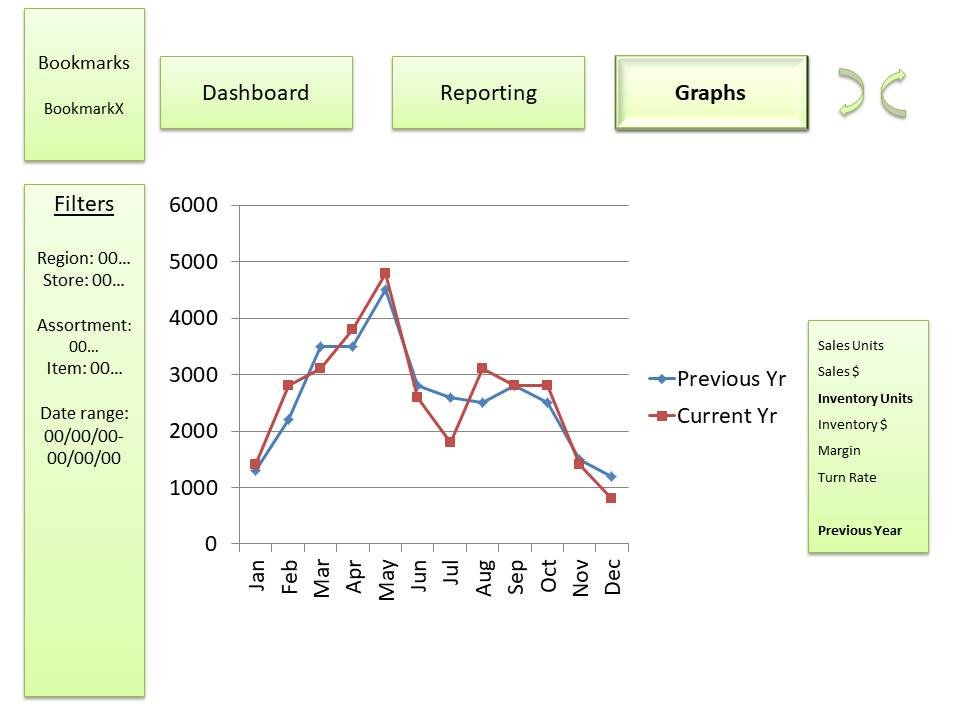 Similar flexibility is given in this tab. The user is able to filter what data is displayed in the graph as well as the date range, i.e. one month or one year. This is used more for a ‘big picture’ outlook than the “Reporting” tab shown previously. Important in this tab is the historical narrative told in the graph.
Similar flexibility is given in this tab. The user is able to filter what data is displayed in the graph as well as the date range, i.e. one month or one year. This is used more for a ‘big picture’ outlook than the “Reporting” tab shown previously. Important in this tab is the historical narrative told in the graph.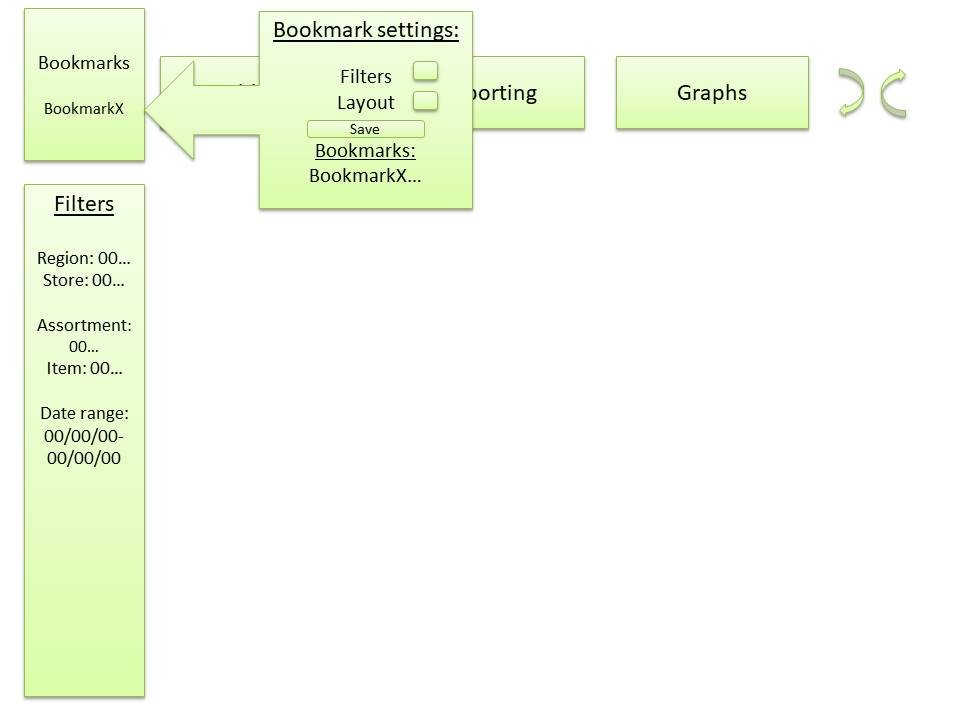 This slide shows the sidebar in action. Keeping in mind this is a low-fidelity wireframe, arrows are used to indicate drop-down or pop-out menus. Bookmarks are of particular importance because clients may be handling different sales accounts on one user login. Bookmarks allow the user to keep different markets and contracts separate when reporting is coming back on one terminal. Previous versions of this web portal implemented bookmarks so it was important that this design kept those intact and only added to their ease of use.
This slide shows the sidebar in action. Keeping in mind this is a low-fidelity wireframe, arrows are used to indicate drop-down or pop-out menus. Bookmarks are of particular importance because clients may be handling different sales accounts on one user login. Bookmarks allow the user to keep different markets and contracts separate when reporting is coming back on one terminal. Previous versions of this web portal implemented bookmarks so it was important that this design kept those intact and only added to their ease of use.
Church Website
firstassemblylajunta.com
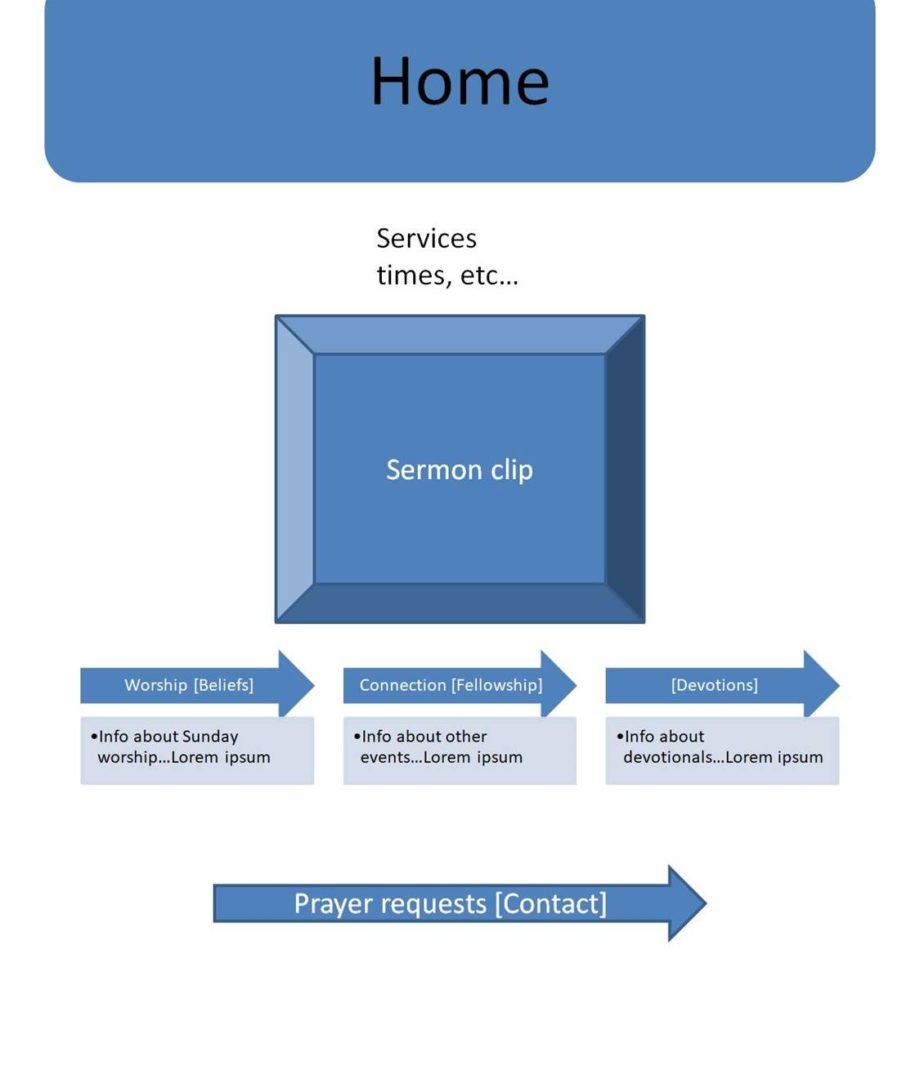 Worked closely with the church to put make their vision a reality. As a church that was growing and seeking new ways to connect with people, we were able to grow our deliverables with what they were wanting long-term. This included being able to post and/or stream sermons through the website. Several options were explored and the client realized that they had several hardware needs on their end to resolve before we could make live-streaming sermons a reality.
Worked closely with the church to put make their vision a reality. As a church that was growing and seeking new ways to connect with people, we were able to grow our deliverables with what they were wanting long-term. This included being able to post and/or stream sermons through the website. Several options were explored and the client realized that they had several hardware needs on their end to resolve before we could make live-streaming sermons a reality.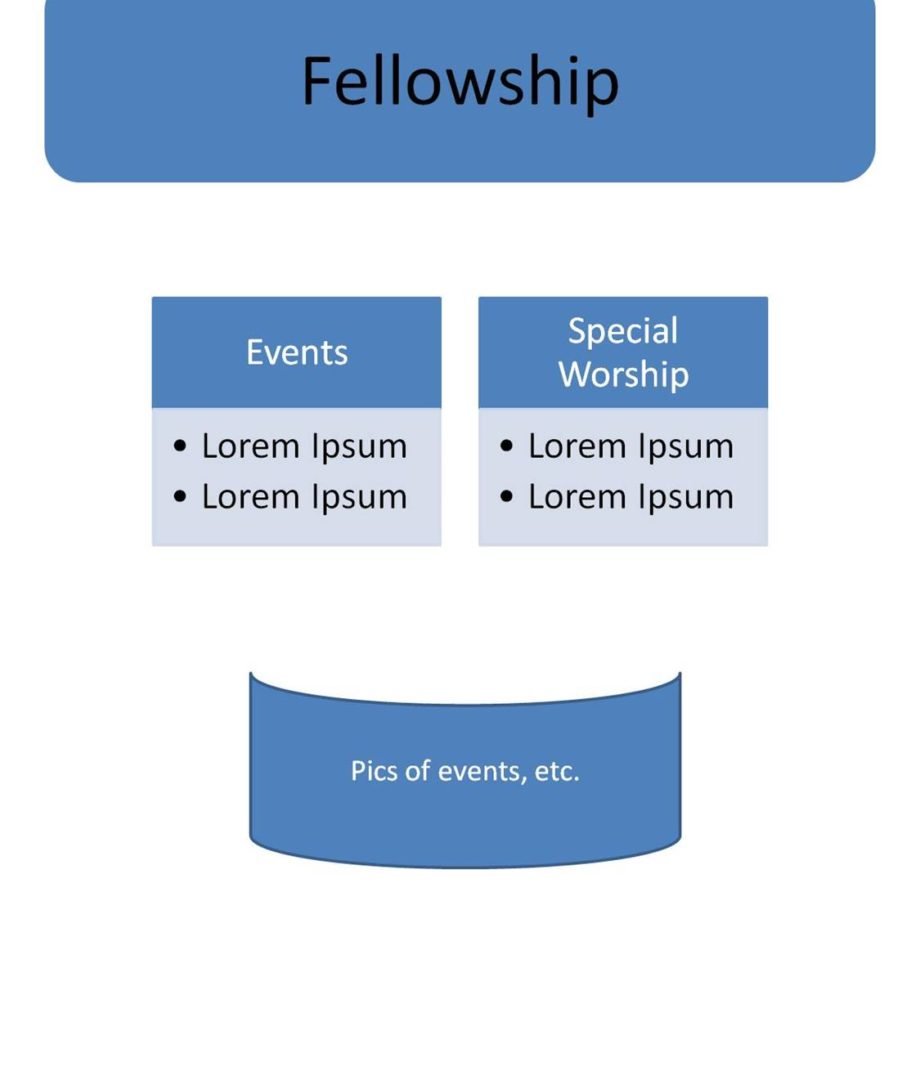 Conveying a church's culture is an important role for any church website and the client had a clear view of what they wanted for content in this area and to have the functionality for ongoing updates of what was on the horizon for the church.
Conveying a church's culture is an important role for any church website and the client had a clear view of what they wanted for content in this area and to have the functionality for ongoing updates of what was on the horizon for the church.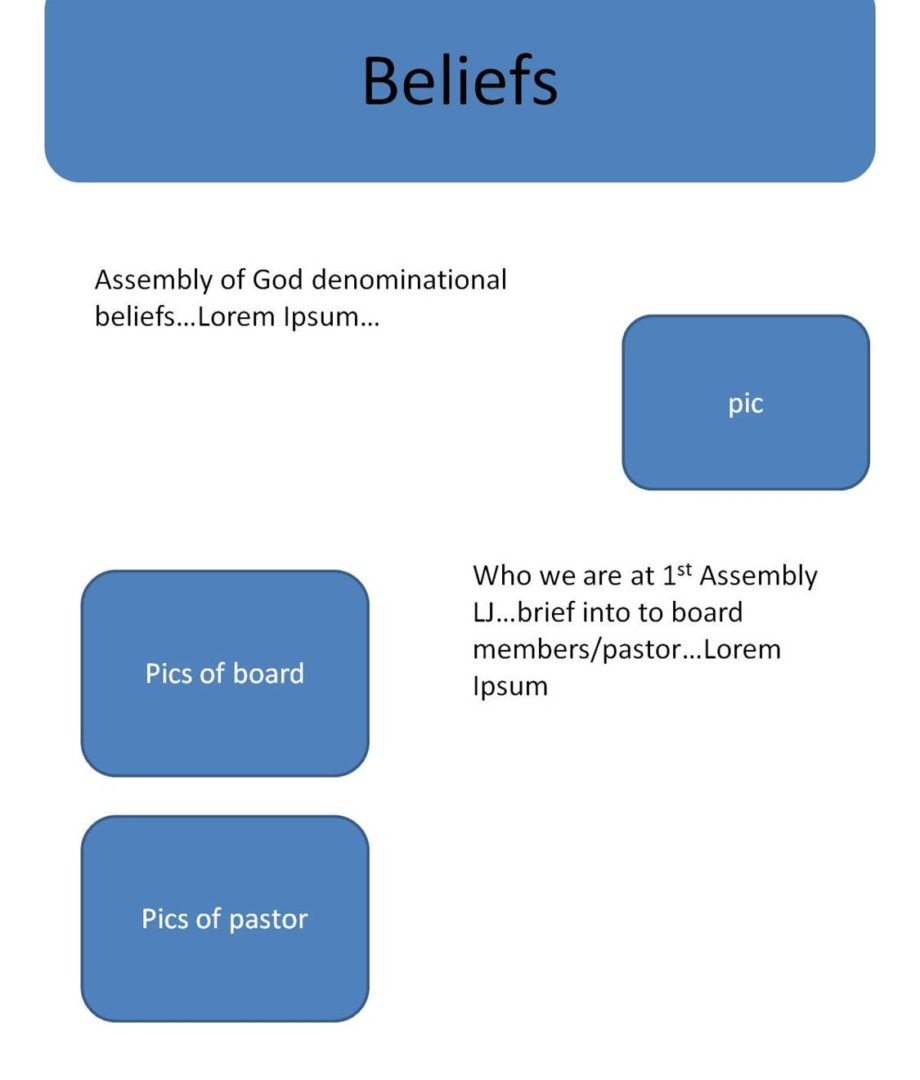 An aspect of a website that trumps social media is being able to have permanence. No better place for that than in conveying longstanding beliefs and creeds of a religious group. This was also a place where the client wanted introductions to the church staff, not uncommon for many church websites.
An aspect of a website that trumps social media is being able to have permanence. No better place for that than in conveying longstanding beliefs and creeds of a religious group. This was also a place where the client wanted introductions to the church staff, not uncommon for many church websites.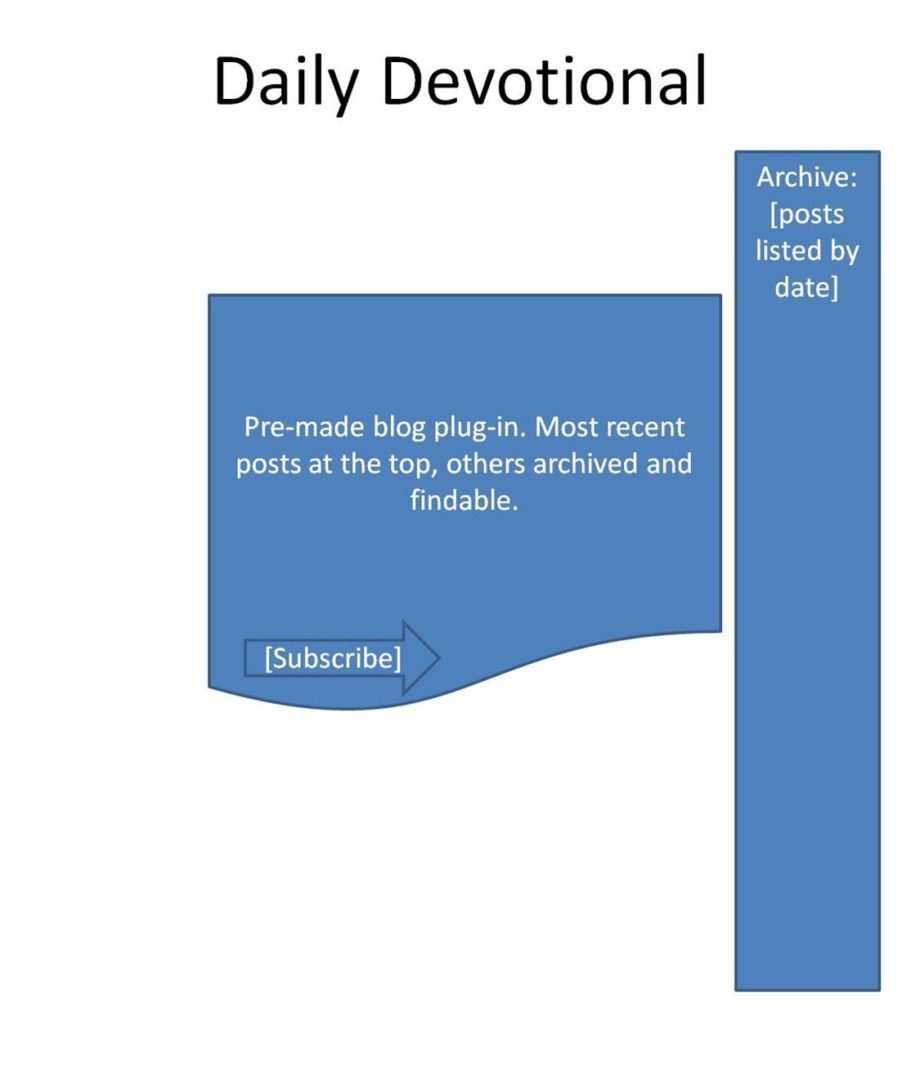 Part of the vision was a way to migrate the pastor's current devotionals to the online platform. Using built-in blogging plugins, we were able to realize that goal and reach even more people.
Part of the vision was a way to migrate the pastor's current devotionals to the online platform. Using built-in blogging plugins, we were able to realize that goal and reach even more people.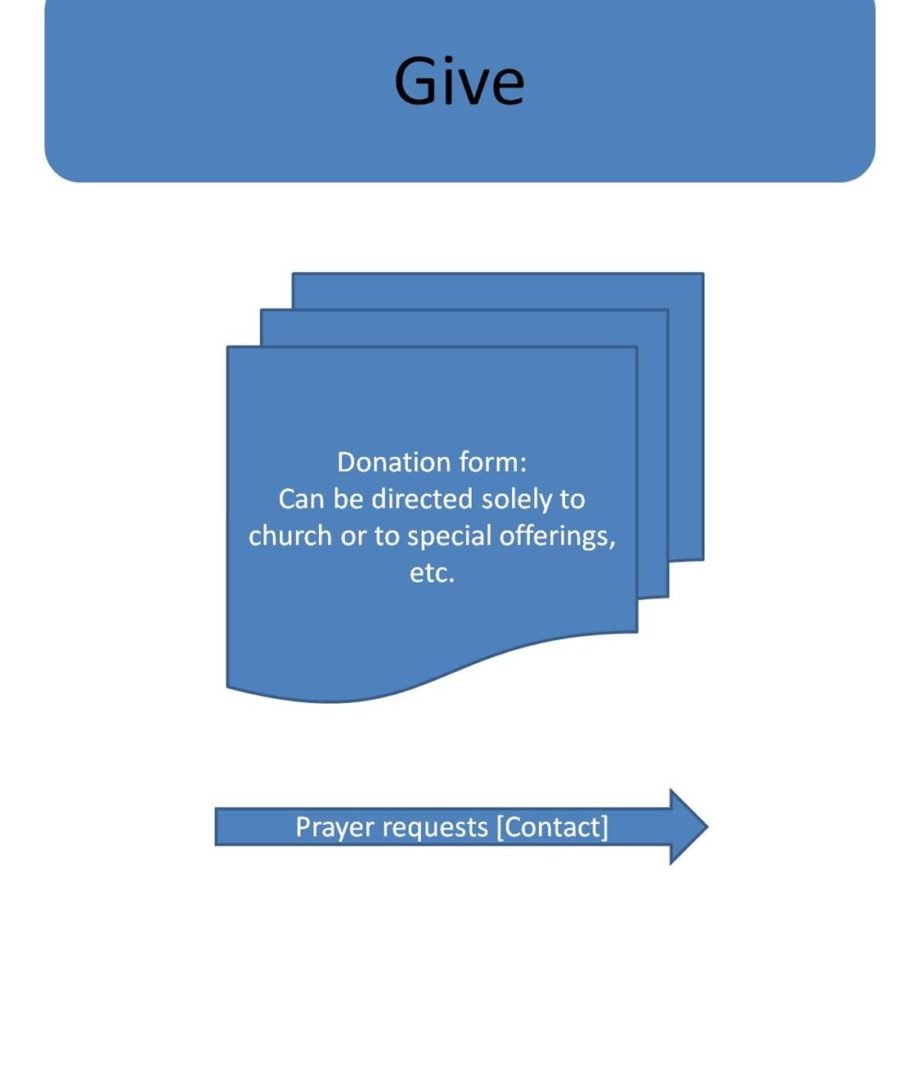 Being able to handle online giving was a huge way to add value to the client by making it easier for people to donate and setup recurring donations if wanted. The idea was to make this process as easy as possible.
Being able to handle online giving was a huge way to add value to the client by making it easier for people to donate and setup recurring donations if wanted. The idea was to make this process as easy as possible.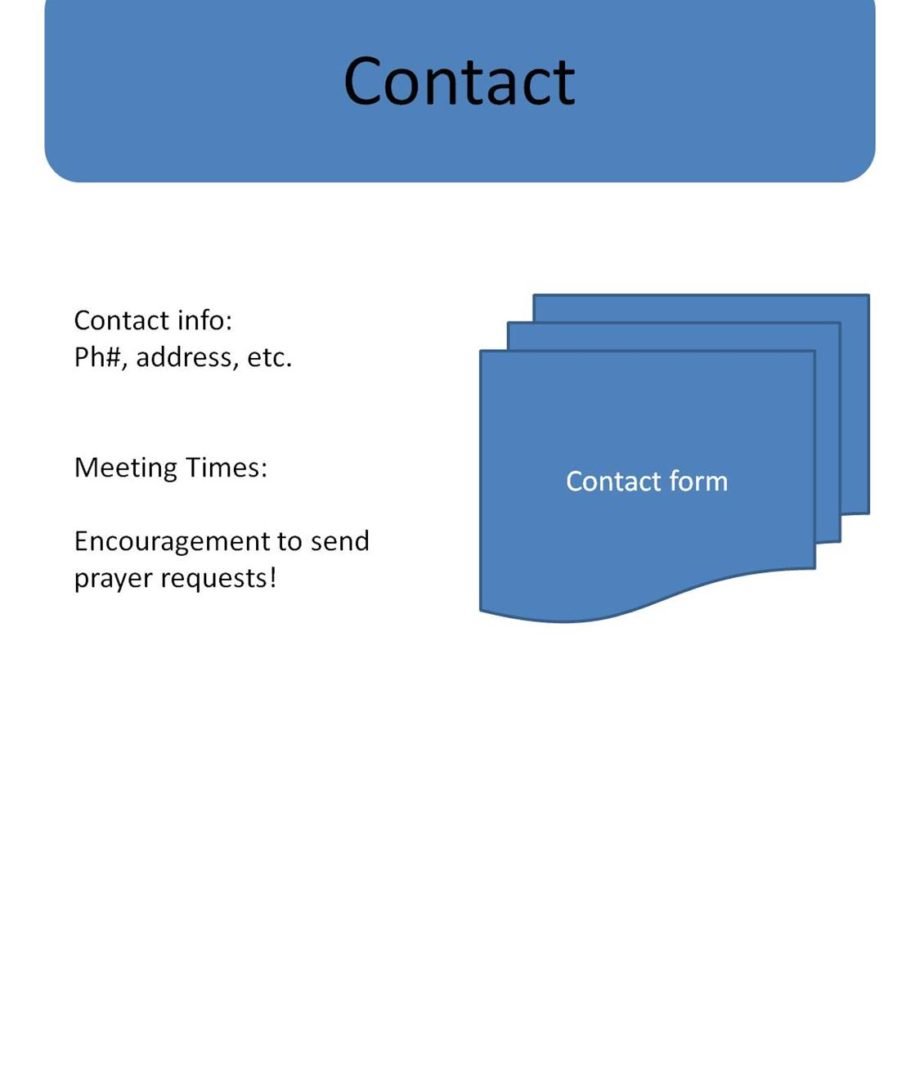 We wanted to add something more to the contact form by way of addressing the multiple ways it could be used. Including meeting times for the church as well as encouraging visitors to the website to send prayer requests, we were able to take something that is often very generic and make it have more value.
We wanted to add something more to the contact form by way of addressing the multiple ways it could be used. Including meeting times for the church as well as encouraging visitors to the website to send prayer requests, we were able to take something that is often very generic and make it have more value.
Church Website
trinitylajunta.com
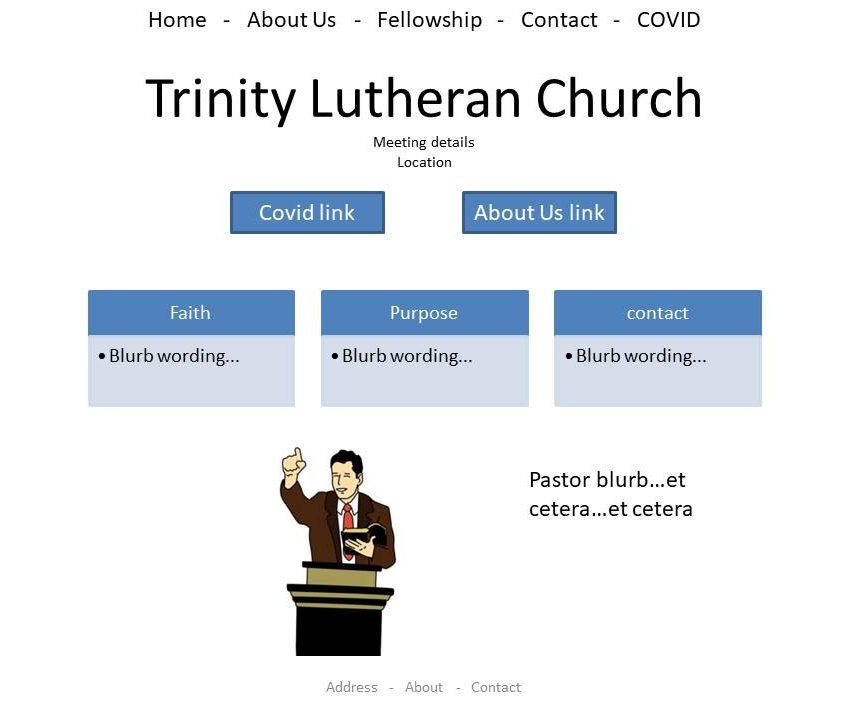 This is a low fidelity wireframe for a quick project creating a website for a non-profit, religious organization. The home/welcome page is designed to give the most important information first while still intriguing visitors and giving them further content. Links to other pages would be added within the home page content where appropriate.
This is a low fidelity wireframe for a quick project creating a website for a non-profit, religious organization. The home/welcome page is designed to give the most important information first while still intriguing visitors and giving them further content. Links to other pages would be added within the home page content where appropriate.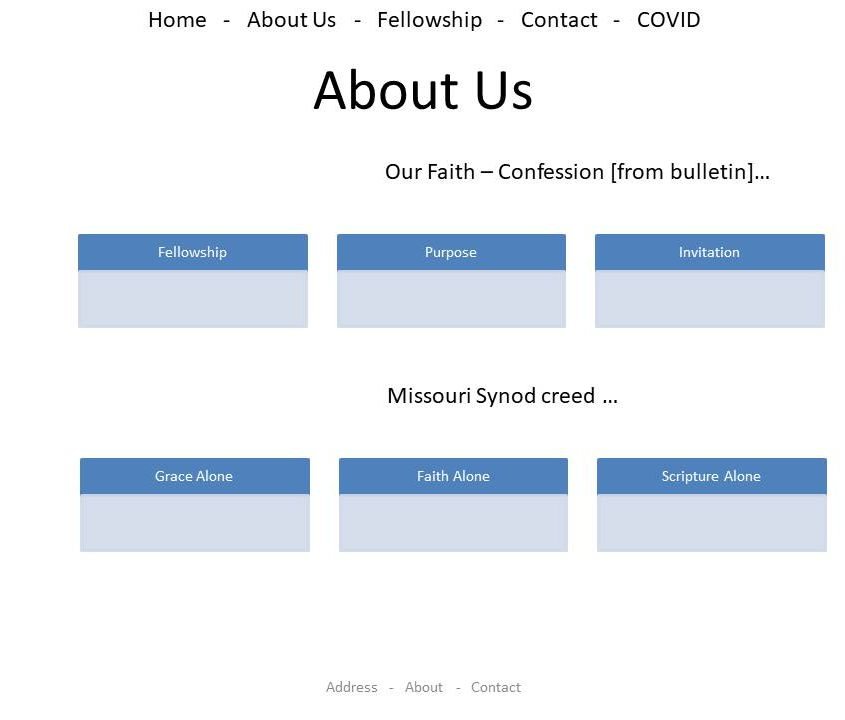 This page gives more information about the church's goals and creeds. Breaking down this information that could otherwise be very difficult to read was very important. Triple bullet-point styled blocks break up the monotony of ongoing text.
This page gives more information about the church's goals and creeds. Breaking down this information that could otherwise be very difficult to read was very important. Triple bullet-point styled blocks break up the monotony of ongoing text.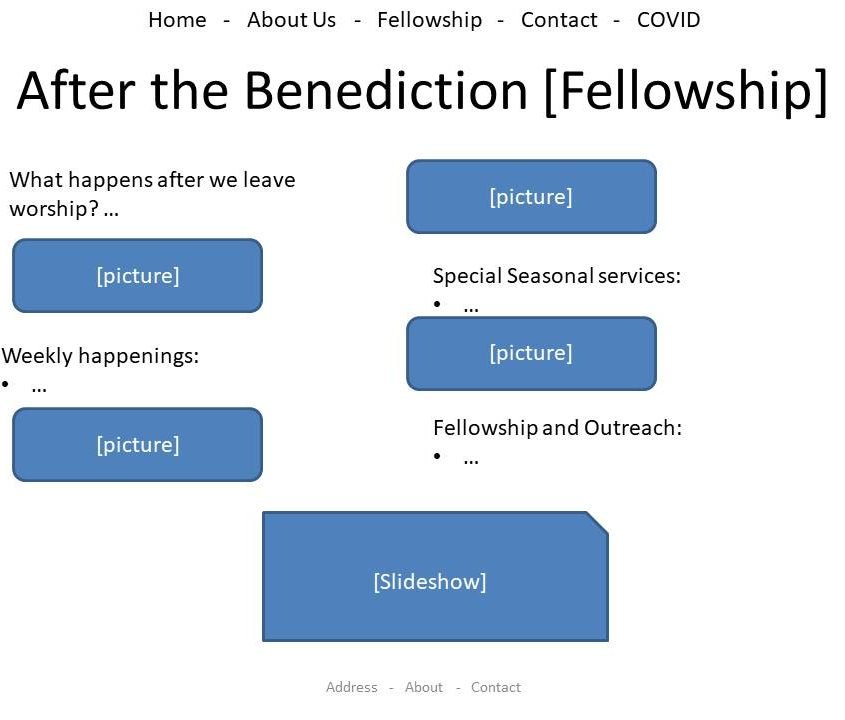 The client for this project requested a page for posting their ongoing happenings and highlighting past events. I decided that rather than create a calendar which would have to be updated constantly by the client, I would create categories of events. Since the majority of their events followed a similar timeline, this list would not have to be updated as frequently and could remain almost entirely the same year over year. It also allowed a space to naturally showcase the church's fellowship and provide more interesting content with pictures.
The client for this project requested a page for posting their ongoing happenings and highlighting past events. I decided that rather than create a calendar which would have to be updated constantly by the client, I would create categories of events. Since the majority of their events followed a similar timeline, this list would not have to be updated as frequently and could remain almost entirely the same year over year. It also allowed a space to naturally showcase the church's fellowship and provide more interesting content with pictures.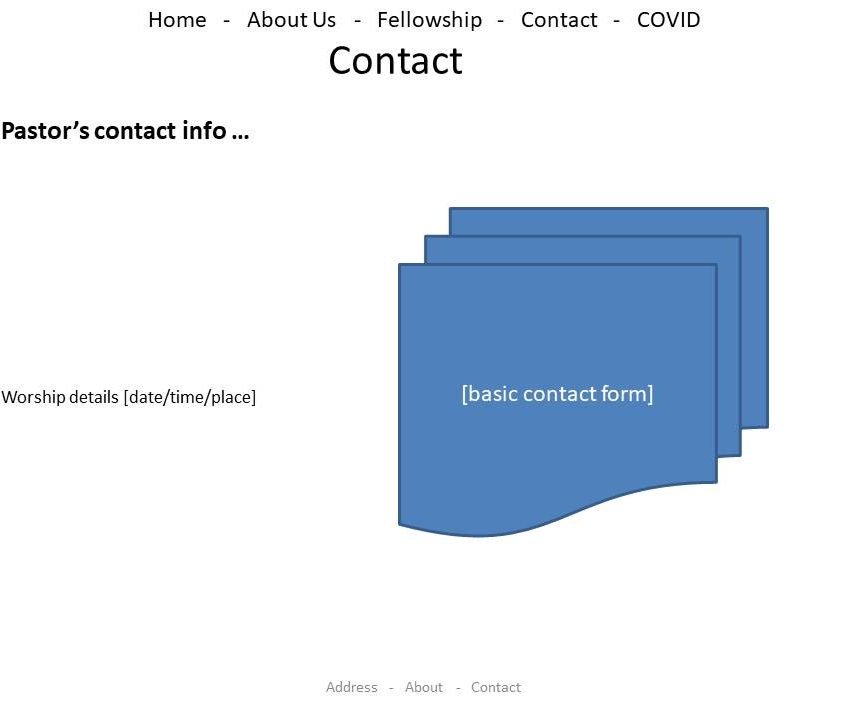 This page was a simple contact form which reiterated the church's worship times and also gave the physical location and mailing address.
This page was a simple contact form which reiterated the church's worship times and also gave the physical location and mailing address.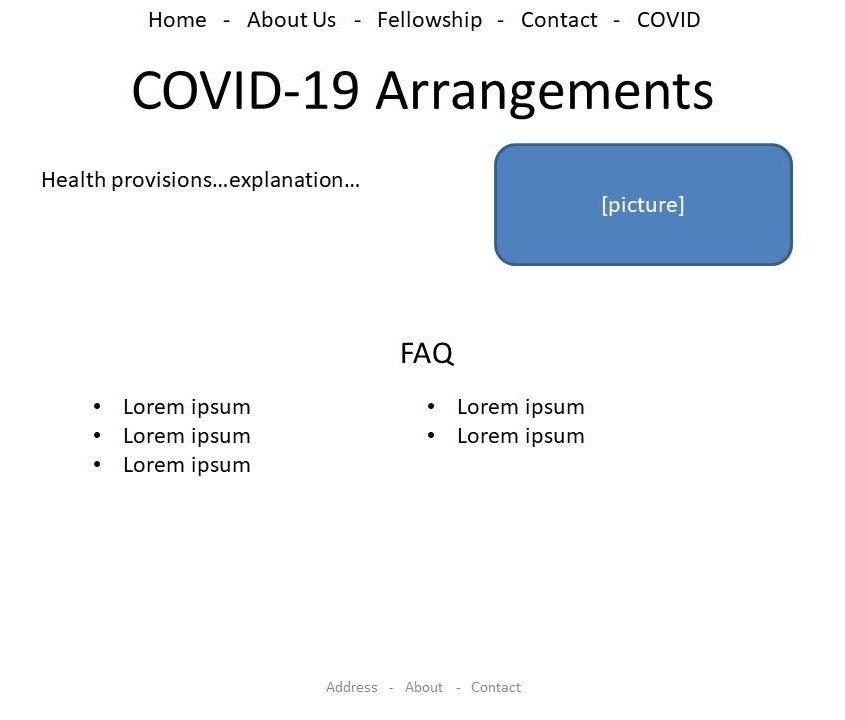 Due to the ongoing challenges that the COVID-19 pandemic created, it was necessary to create a separate page to address any changes that would be made due to the level of quarantine, etc. Whenever people go into a public setting they want to know the protocols and expectations. This is difficult to do in a constantly changing pandemic and so this page address those concerns and provides answers to common questions.
Due to the ongoing challenges that the COVID-19 pandemic created, it was necessary to create a separate page to address any changes that would be made due to the level of quarantine, etc. Whenever people go into a public setting they want to know the protocols and expectations. This is difficult to do in a constantly changing pandemic and so this page address those concerns and provides answers to common questions.
Product Design Showcase – livegoods
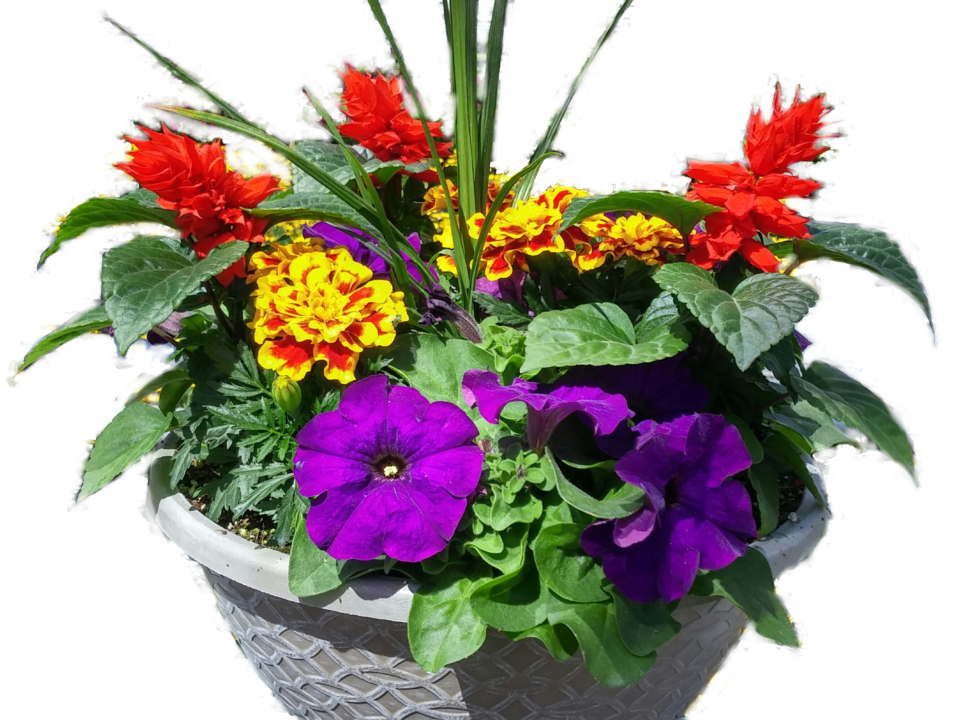 Prime Colorbowl-spring: Draceana, French Marigold, Petunia, Salvia splendens Numerous colorbowls needed to be designed for the prime season in multiple markets. Of the four combos I proposed, all four were selected for production. This item was created as an earlier selection including components many people would be familiar with in mid spring.
Prime Colorbowl-spring: Draceana, French Marigold, Petunia, Salvia splendens Numerous colorbowls needed to be designed for the prime season in multiple markets. Of the four combos I proposed, all four were selected for production. This item was created as an earlier selection including components many people would be familiar with in mid spring.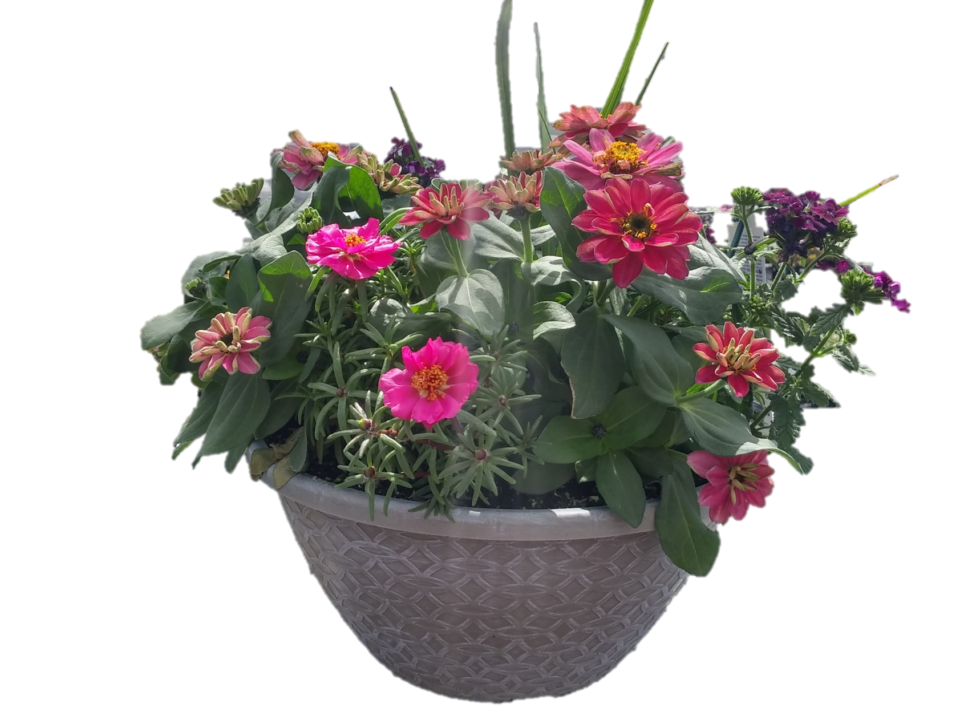 Prime Colorbowl-full sun: Dracaena, Portulaca, Verbena, Zinnia This item was another of the heat-tolerant prime combinations selected.
Prime Colorbowl-full sun: Dracaena, Portulaca, Verbena, Zinnia This item was another of the heat-tolerant prime combinations selected.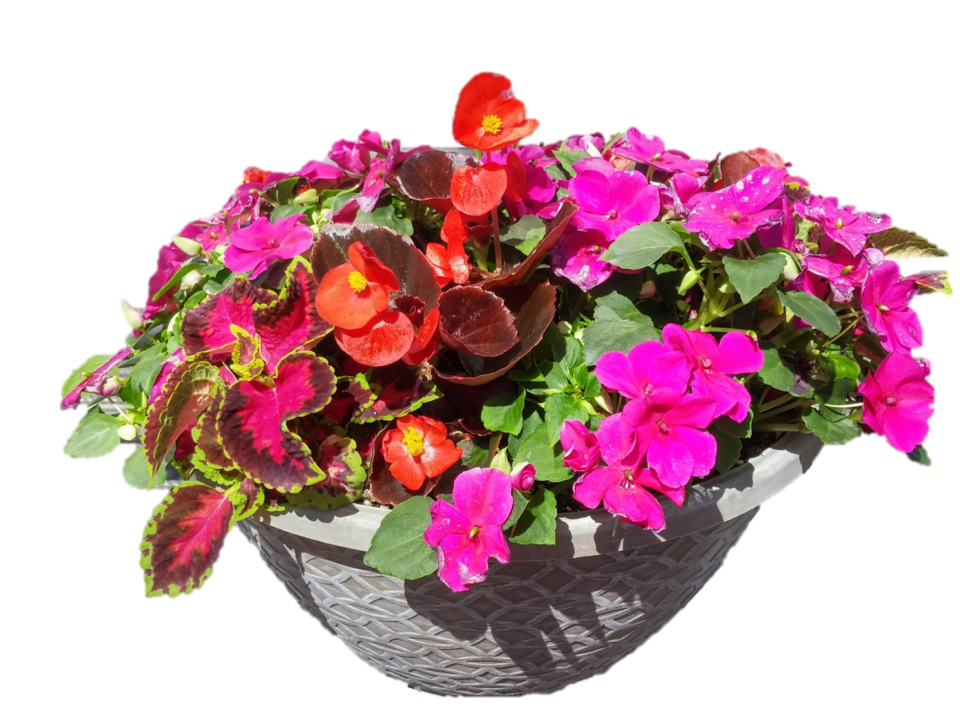 Prime Colorbowl-shade: Fibrous Begonia, Coleus, Dracaena, Impatiens elfin Both the buyer and the end users had requested combos that would perform well in shaded environments. This was a novel combination since most nursery providers produced exclusively ‘sunny’ combinations. This item, and other combinations like it, were a hit item and more like it were requested every year.
Prime Colorbowl-shade: Fibrous Begonia, Coleus, Dracaena, Impatiens elfin Both the buyer and the end users had requested combos that would perform well in shaded environments. This was a novel combination since most nursery providers produced exclusively ‘sunny’ combinations. This item, and other combinations like it, were a hit item and more like it were requested every year.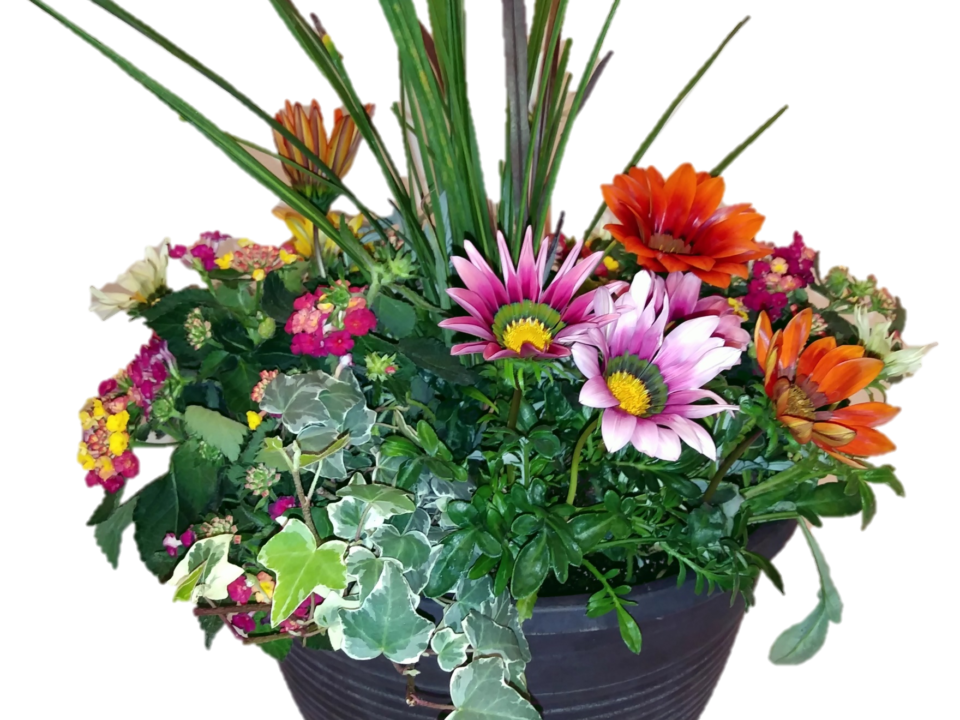 Summer planter combo winner: Dracaena, English Ivy, Gazania, Lantana Part of a facility-wide contest, this combination was selected based on aesthetic appeal and how well the components grew together based on individual plant needs. This combo also filled the need for high-quality late summer/early fall product.
Summer planter combo winner: Dracaena, English Ivy, Gazania, Lantana Part of a facility-wide contest, this combination was selected based on aesthetic appeal and how well the components grew together based on individual plant needs. This combo also filled the need for high-quality late summer/early fall product.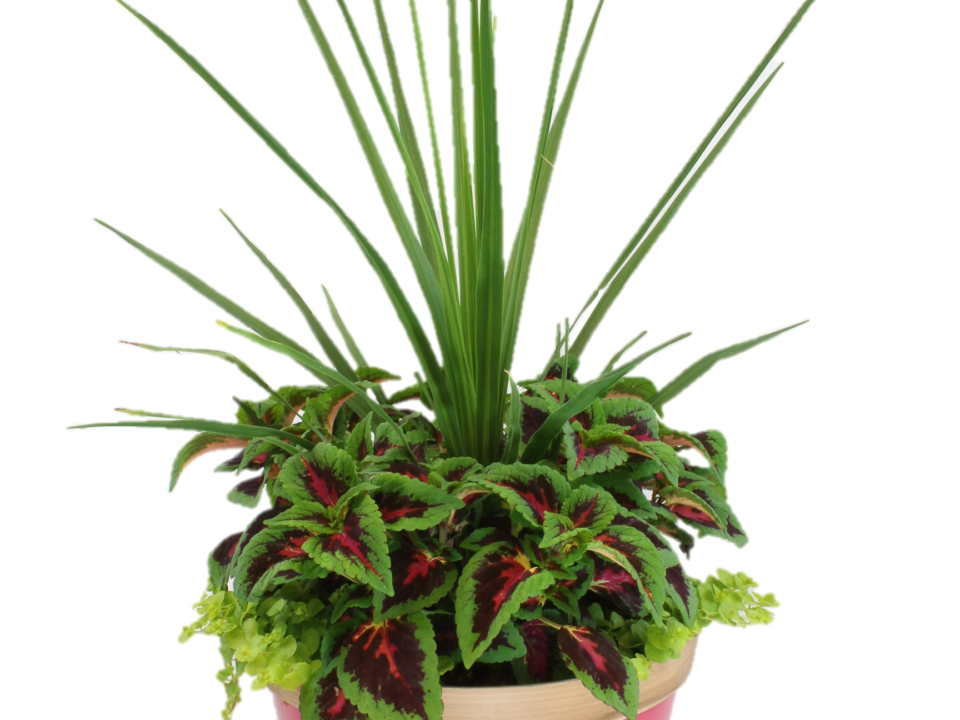 Shade Premium Planter: Coleus “Kong”, Dracaena, Lysmachia The buyer requested a selection of shade-hardy combos based on end-user requests. These combinations had to be created such that all components had the same lighting requirements so that the final customer would not have difficulty maintaining the item.
Shade Premium Planter: Coleus “Kong”, Dracaena, Lysmachia The buyer requested a selection of shade-hardy combos based on end-user requests. These combinations had to be created such that all components had the same lighting requirements so that the final customer would not have difficulty maintaining the item.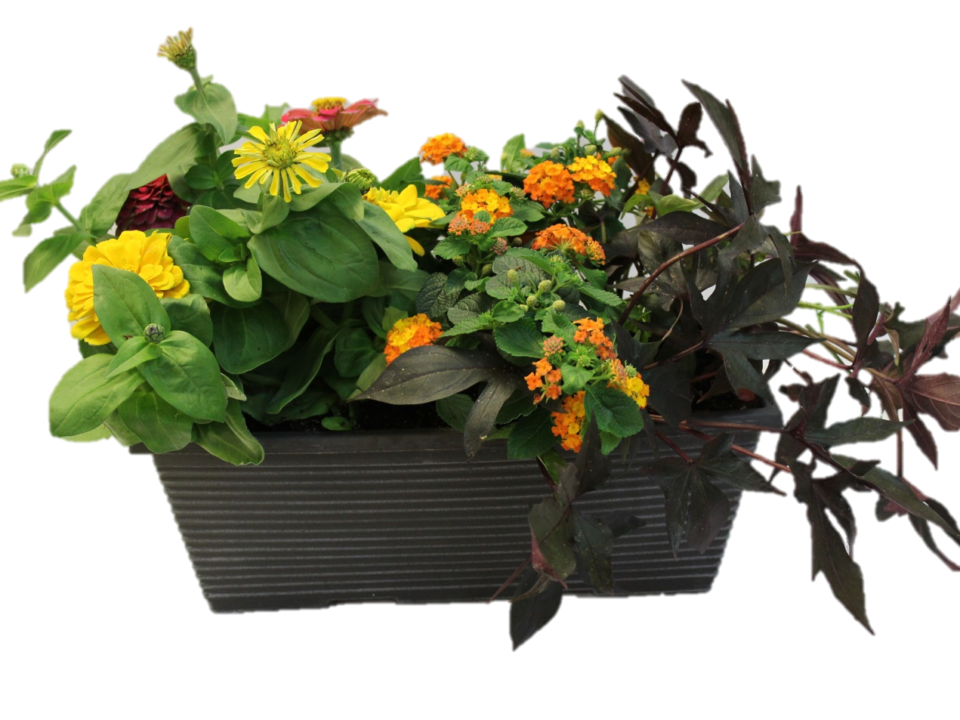 Summer windowbox: Ipomoea Batatas, Lantana, Zinnia This was an item created in rapid development. Most items went through a long planning and approval process but this item was created to fill an immediate need for summer combos. This particular design would be placed in a window or other narrow space with full-sun.
Summer windowbox: Ipomoea Batatas, Lantana, Zinnia This was an item created in rapid development. Most items went through a long planning and approval process but this item was created to fill an immediate need for summer combos. This particular design would be placed in a window or other narrow space with full-sun.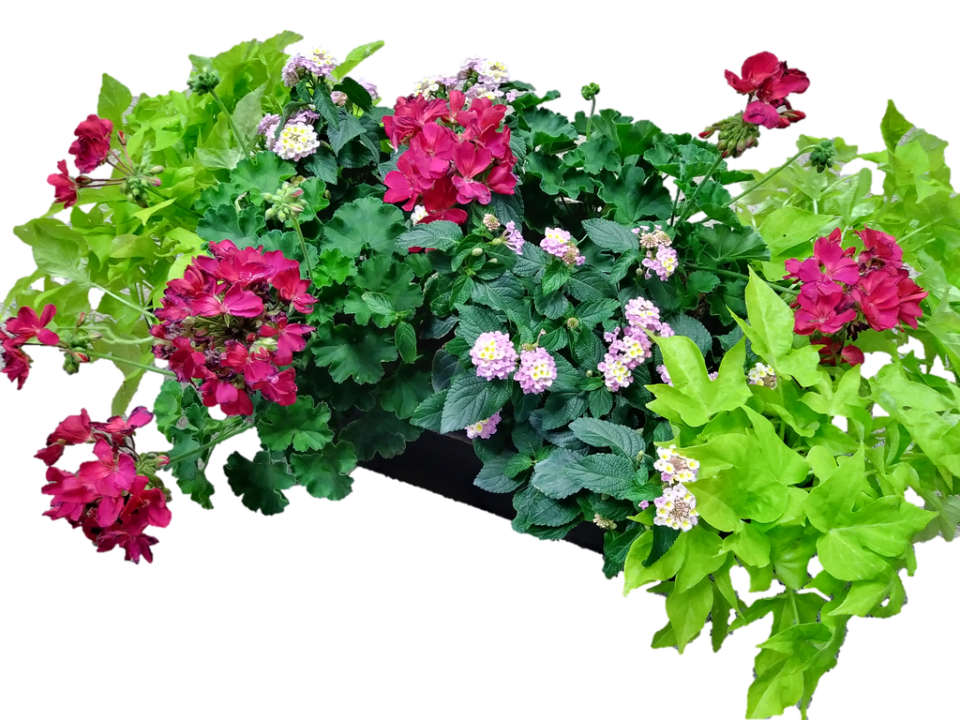 Summer Rail Planter: Caliope Geranium, Ipomoea Batatas “Lime”, Lantana This was a trial item that performed especially well. The idea was to have a planter that could sit on a porch rail (or similar support). In order to extend the item utility, different plants needed to be selected that would thrive in different markets and seasons, especially in full-sun. The combo shown was the summer selection.
Summer Rail Planter: Caliope Geranium, Ipomoea Batatas “Lime”, Lantana This was a trial item that performed especially well. The idea was to have a planter that could sit on a porch rail (or similar support). In order to extend the item utility, different plants needed to be selected that would thrive in different markets and seasons, especially in full-sun. The combo shown was the summer selection. Summer planter combo winner: Dracaena, English Ivy, Gazania, Lantana Part of a facility-wide contest, this combination was selected based on aesthetic appeal and how well the components grew together based on individual plant needs. This combo also filled the need for high-quality late summer/early fall product.
Summer planter combo winner: Dracaena, English Ivy, Gazania, Lantana Part of a facility-wide contest, this combination was selected based on aesthetic appeal and how well the components grew together based on individual plant needs. This combo also filled the need for high-quality late summer/early fall product.
Time Study
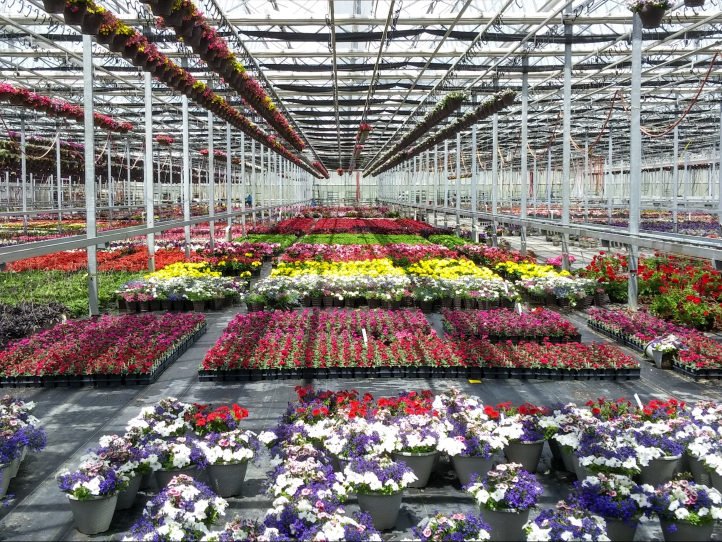 This project was purposed to measure time requirements for harvesting product in an industrial greenhouse and conducted at the behest of the corporation in conjunction with Altman Plants’ managers. This provided for a unique setting in which to conduct the study because of the nature of the agriculture industry and because many of the study participants had Spanish as first language and not all understood fluent English. This study investigated several aspects of the greenhouse collection process. In doing so, a key question was how to increase efficiency and reduce manpower requirements without adding time. This was vital information since labor is the single highest cost in agriculture.
This project was purposed to measure time requirements for harvesting product in an industrial greenhouse and conducted at the behest of the corporation in conjunction with Altman Plants’ managers. This provided for a unique setting in which to conduct the study because of the nature of the agriculture industry and because many of the study participants had Spanish as first language and not all understood fluent English. This study investigated several aspects of the greenhouse collection process. In doing so, a key question was how to increase efficiency and reduce manpower requirements without adding time. This was vital information since labor is the single highest cost in agriculture.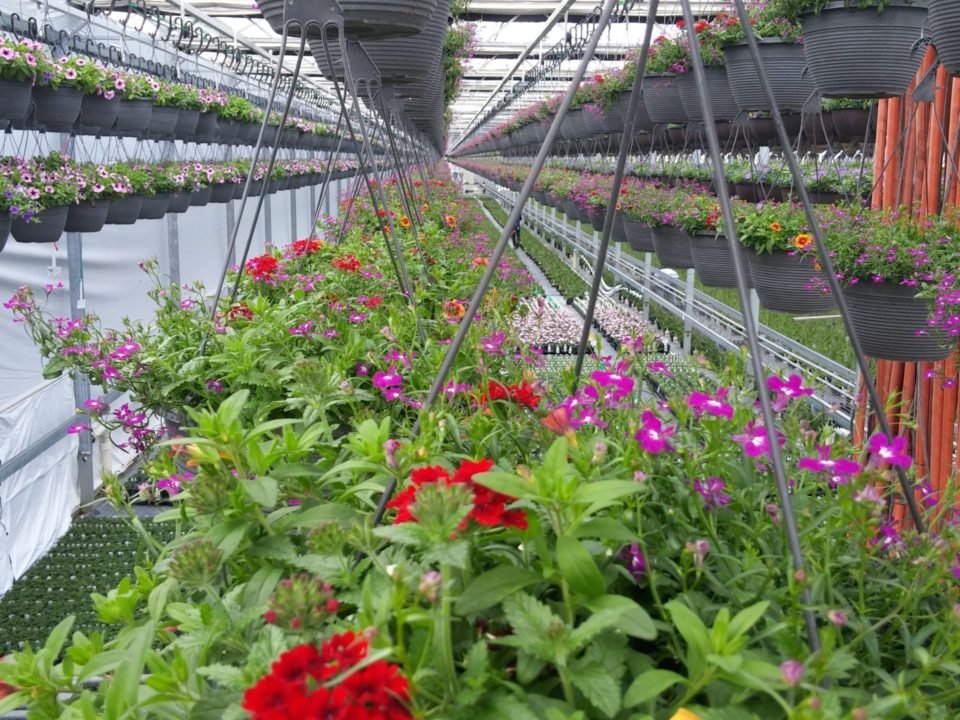 When gathering data, to get a good sample size researchers often use either a small group followed over a long time or a large group in a short timeframe. It was determined that distributing the task of data collection to the product collection teams would be the best way to gather a large sample of data in a short time.
When gathering data, to get a good sample size researchers often use either a small group followed over a long time or a large group in a short timeframe. It was determined that distributing the task of data collection to the product collection teams would be the best way to gather a large sample of data in a short time.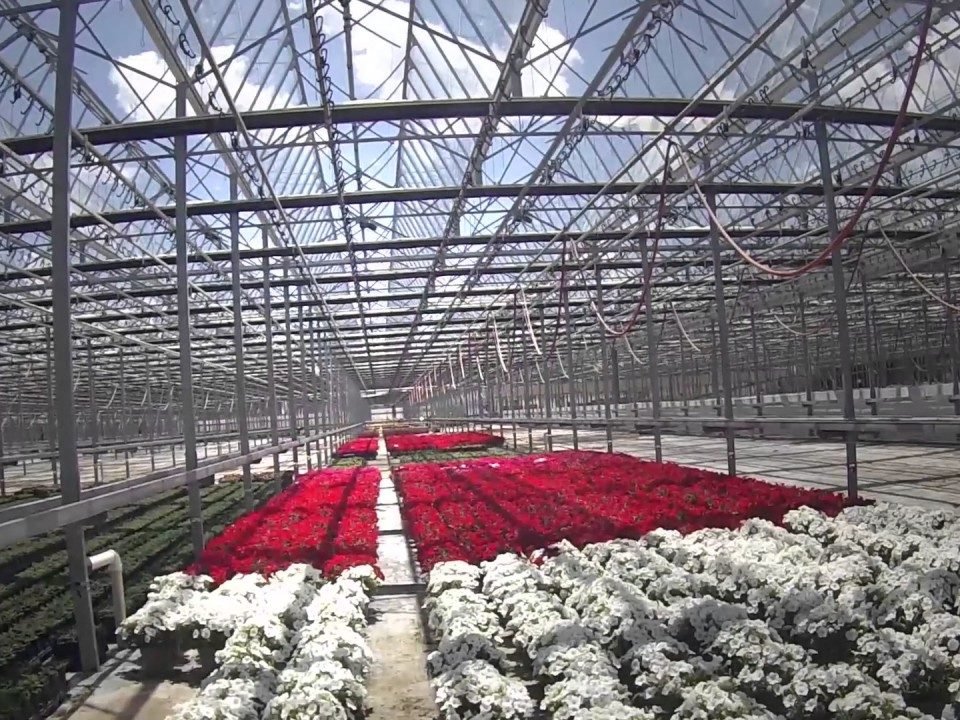 There was some difficulty initially with communicating the purpose and data needs to the collection team, largely due to the language barrier. Another difficulty with collecting data in the agriculture industry is that seasonality means time is of the essence. If a week of data is missed it is gone forever and cannot be replicated until the next year.
There was some difficulty initially with communicating the purpose and data needs to the collection team, largely due to the language barrier. Another difficulty with collecting data in the agriculture industry is that seasonality means time is of the essence. If a week of data is missed it is gone forever and cannot be replicated until the next year.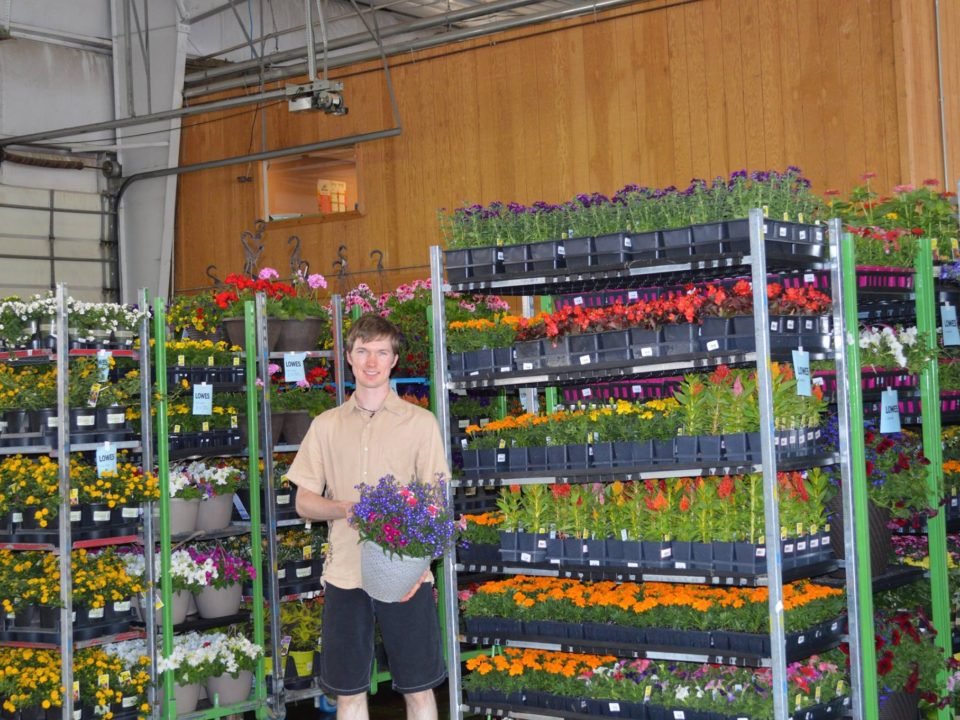 At the conclusion of the data collection phase, results were drawn using ANOVA to determine if collection team size and type of product collected had an impact on collection rates. Tukey’s HSD post hoc test was used to determine where significant variance existed. These results were then presented to the department manager to aid in determining areas for improvement and where item cost was significantly impacted by collection rate.
At the conclusion of the data collection phase, results were drawn using ANOVA to determine if collection team size and type of product collected had an impact on collection rates. Tukey’s HSD post hoc test was used to determine where significant variance existed. These results were then presented to the department manager to aid in determining areas for improvement and where item cost was significantly impacted by collection rate.
Demographic Statistics Research
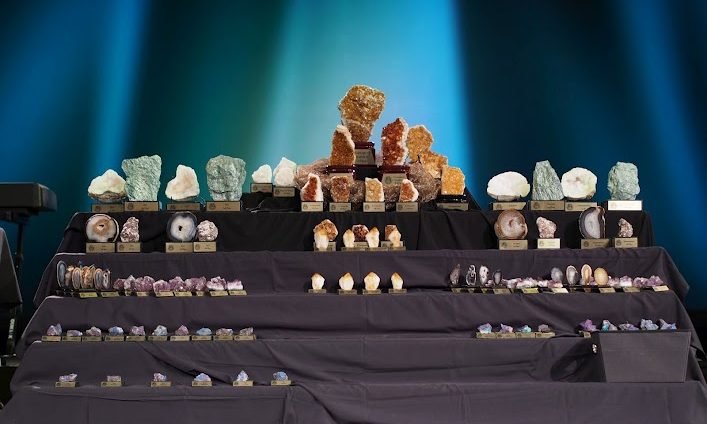 My first capstone project, this data analysis was conducted as community service to help a speech and debate league to gather an analyze data concerning their judge pool. In order to aid tournament planning, this project looked at the characteristics of the tournament judge pool in several ways. What are the judge pool characteristics?
My first capstone project, this data analysis was conducted as community service to help a speech and debate league to gather an analyze data concerning their judge pool. In order to aid tournament planning, this project looked at the characteristics of the tournament judge pool in several ways. What are the judge pool characteristics?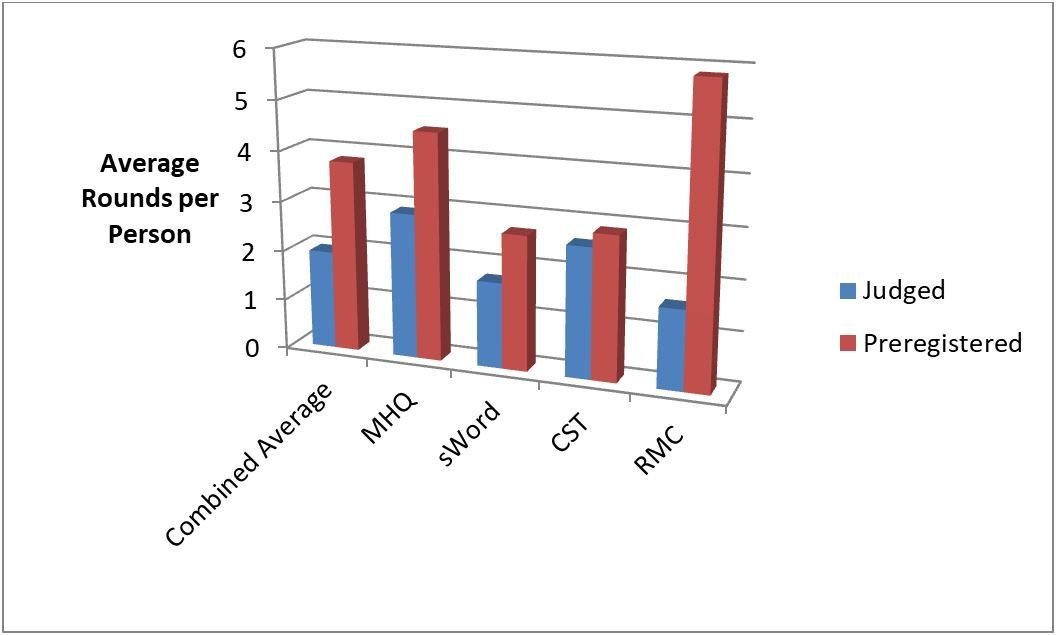 How many judge the same rounds for which they have preregistered? Given the initial preregistration before the start of the tournament, how many will actually judge the round they registered for? This is useful information in planning how many slots may need to be filled with walk-in judges (see above).
How many judge the same rounds for which they have preregistered? Given the initial preregistration before the start of the tournament, how many will actually judge the round they registered for? This is useful information in planning how many slots may need to be filled with walk-in judges (see above).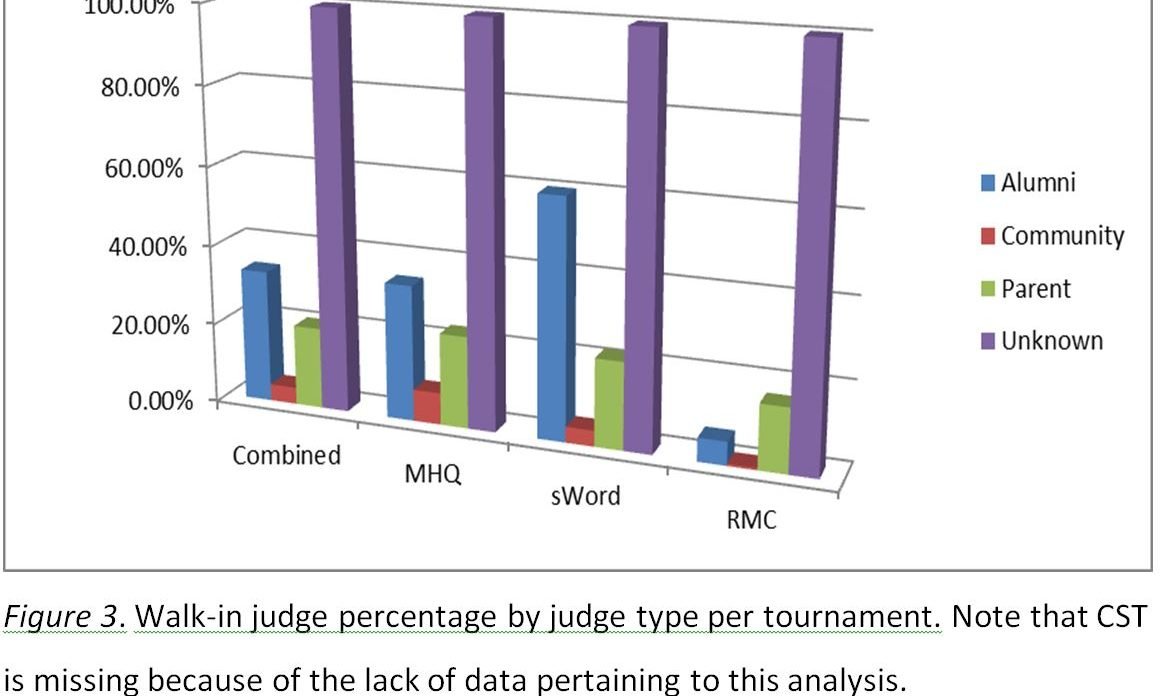 How many register online versus walk-in? This is important in planning how many judges will attend a given competition round. It also aids in balloting by estimating how many of each judge type will preregister or walk-in.
How many register online versus walk-in? This is important in planning how many judges will attend a given competition round. It also aids in balloting by estimating how many of each judge type will preregister or walk-in.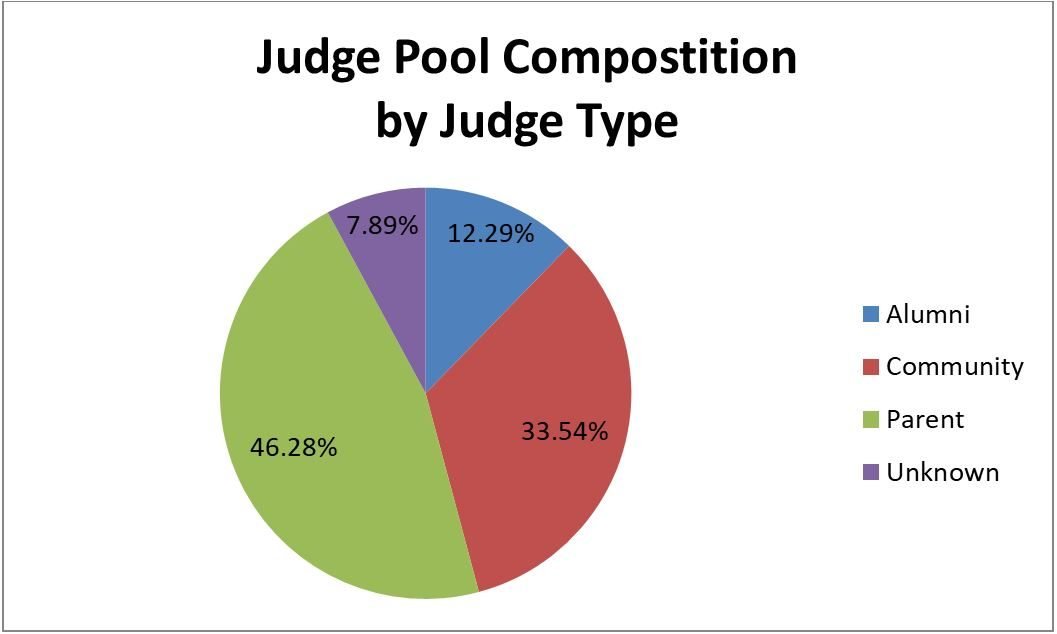 What are the changes in quantity and diversity of judges by day, time, and location? This is vital to planning tournaments and balloting competition rounds. When certain locations and time of day provide more diversity or more of one judge type, tournament staff can plan accordingly.
What are the changes in quantity and diversity of judges by day, time, and location? This is vital to planning tournaments and balloting competition rounds. When certain locations and time of day provide more diversity or more of one judge type, tournament staff can plan accordingly.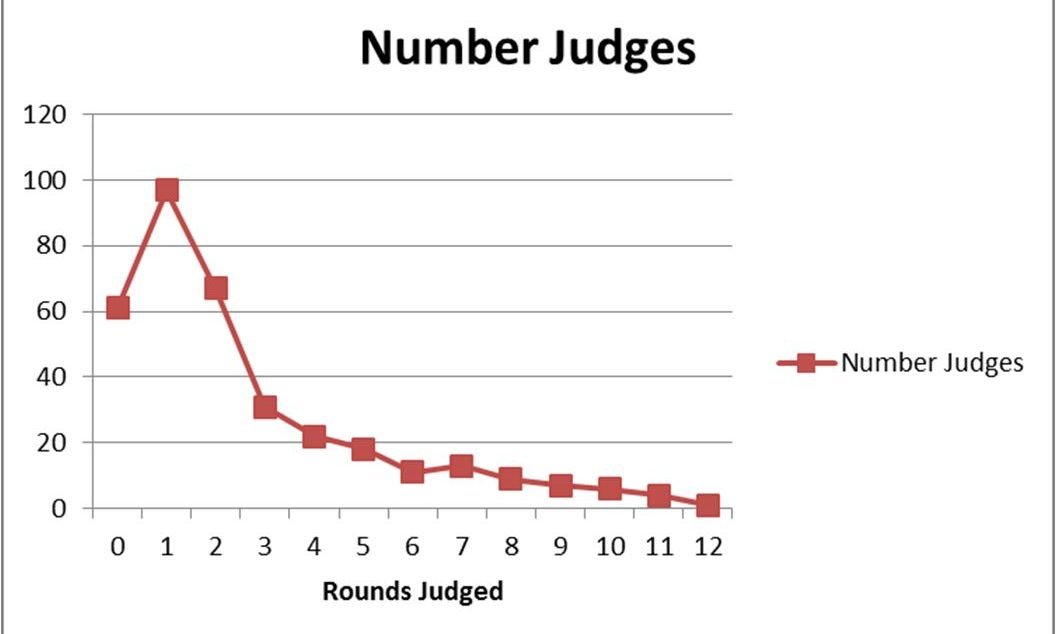 Looking at half a dozen tournaments and personally compiling that data, I was able to deliver to the state committee the final results. These results were later helpful in determining how many judges would be needed for each tournament round and for creating recruitment benchmarks.
Looking at half a dozen tournaments and personally compiling that data, I was able to deliver to the state committee the final results. These results were later helpful in determining how many judges would be needed for each tournament round and for creating recruitment benchmarks.